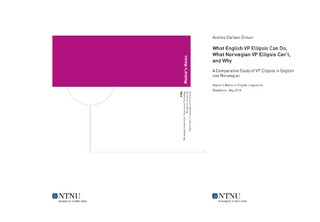What English VP Ellipsis Can Do, What Norwegian VP Ellipsis Can't, and Why - A Comparative Study of VP Ellipsis in English and Norwegian
Master thesis
Permanent lenke
http://hdl.handle.net/11250/2568641Utgivelsesdato
2018Metadata
Vis full innførselSamlinger
Sammendrag
This quantitative study compares the anaphoric phenomenon Verb Phrase Ellipsis (VPE) in English and Norwegian. The main aim of the thesis is to investigate and compare licensing conditions on VPE in these two languages. The most part of previous VPE studies have generally focused on English and/or other more dominating languages. The Norwegian auxiliaries tested for in this study are må ‘must’, ha ‘have’, være ‘be’ and bli ‘become’. The study’s design consists of an online survey asking for acceptability judgments of 48 test items on a Likert scale ranging from 1-7. In total, there were 426 Norwegian native speakers participating. The data on Norwegian VPE come from judgments these participants gave, and data on English VPE come from other linguistic research conducted for the most part within the last few decades. The results in the current study show evidence of lower acceptance of Norwegian VPE-constructions containing the adverb også ‘too’. Contrarily, the English equivalent ‘too’ is felicitous in VPE sites, and this difference is discussed in depth in the analysis. The test items that received highest acceptability mean score were ellipsis sites containing no adverb at all. Furthermore, this study found a bimodal distribution of opinions on Norwegian VPE and slightly lower acceptance of the auxiliary være ‘be’. A suggested licensing condition on Norwegian VPE is proposed; whether pitch accent is assigned to the auxiliary in the elided phrase is crucial for licensing Norwegian VPE. This entails that it differs from English where pitch accent is allowed on other entities in a VPE than the auxiliary.
